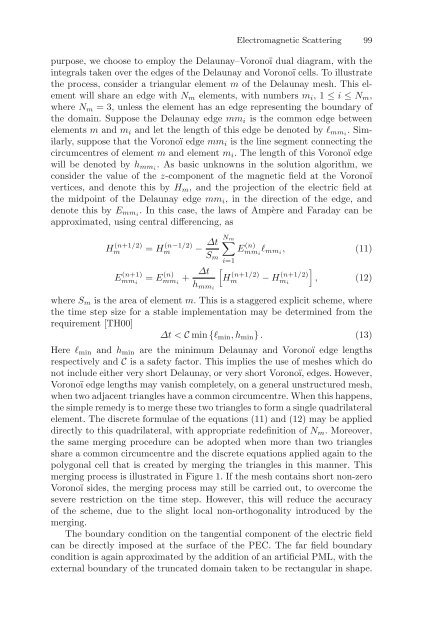Partial Differential Equations - Modelling and ... - ResearchGate
Partial Differential Equations - Modelling and ... - ResearchGate
Partial Differential Equations - Modelling and ... - ResearchGate
Create successful ePaper yourself
Turn your PDF publications into a flip-book with our unique Google optimized e-Paper software.
Electromagnetic Scattering 99<br />
purpose, we choose to employ the Delaunay–Voronoï dual diagram, with the<br />
integrals taken over the edges of the Delaunay <strong>and</strong> Voronoï cells. To illustrate<br />
the process, consider a triangular element m of the Delaunay mesh. This element<br />
will share an edge with N m elements, with numbers m i ,1≤ i ≤ N m ,<br />
where N m = 3, unless the element has an edge representing the boundary of<br />
the domain. Suppose the Delaunay edge mm i is the common edge between<br />
elements m <strong>and</strong> m i <strong>and</strong> let the length of this edge be denoted by l mmi . Similarly,<br />
suppose that the Voronoï edgemm i is the line segment connecting the<br />
circumcentres of element m <strong>and</strong> element m i . The length of this Voronoï edge<br />
will be denoted by h mmi . As basic unknowns in the solution algorithm, we<br />
consider the value of the z-component of the magnetic field at the Voronoï<br />
vertices, <strong>and</strong> denote this by H m , <strong>and</strong> the projection of the electric field at<br />
the midpoint of the Delaunay edge mm i , in the direction of the edge, <strong>and</strong><br />
denote this by E mmi . In this case, the laws of Ampère <strong>and</strong> Faraday can be<br />
approximated, using central differencing, as<br />
H (n+1/2)<br />
m<br />
E (n+1)<br />
mm i<br />
= H (n−1/2)<br />
m<br />
− ∆t ∑N m<br />
S m<br />
i=1<br />
E (n)<br />
mm i<br />
l mmi , (11)<br />
= E mm (n)<br />
i<br />
+<br />
∆t [<br />
]<br />
H m<br />
(n+1/2) − H m (n+1/2)<br />
h i<br />
, (12)<br />
mmi<br />
where S m is the area of element m. This is a staggered explicit scheme, where<br />
the time step size for a stable implementation may be determined from the<br />
requirement [TH00]<br />
∆t < C min {l min ,h min } . (13)<br />
Here l min <strong>and</strong> h min are the minimum Delaunay <strong>and</strong> Voronoï edge lengths<br />
respectively <strong>and</strong> C is a safety factor. This implies the use of meshes which do<br />
not include either very short Delaunay, or very short Voronoï, edges. However,<br />
Voronoï edge lengths may vanish completely, on a general unstructured mesh,<br />
when two adjacent triangles have a common circumcentre. When this happens,<br />
the simple remedy is to merge these two triangles to form a single quadrilateral<br />
element. The discrete formulae of the equations (11) <strong>and</strong> (12) may be applied<br />
directly to this quadrilateral, with appropriate redefinition of N m . Moreover,<br />
the same merging procedure can be adopted when more than two triangles<br />
share a common circumcentre <strong>and</strong> the discrete equations applied again to the<br />
polygonal cell that is created by merging the triangles in this manner. This<br />
merging process is illustrated in Figure 1. If the mesh contains short non-zero<br />
Voronoï sides, the merging process may still be carried out, to overcome the<br />
severe restriction on the time step. However, this will reduce the accuracy<br />
of the scheme, due to the slight local non-orthogonality introduced by the<br />
merging.<br />
The boundary condition on the tangential component of the electric field<br />
can be directly imposed at the surface of the PEC. The far field boundary<br />
condition is again approximated by the addition of an artificial PML, with the<br />
external boundary of the truncated domain taken to be rectangular in shape.
















